The Cooler Master V850 SFX Gold ATX 3.0 PSU Review: Small Scale
by E. Fylladitakis on June 20, 2024 11:00 AM EST- Posted in
- Cases/Cooling/PSUs
- PSUs
- Cooler Master
- 80Plus Gold
- SFX
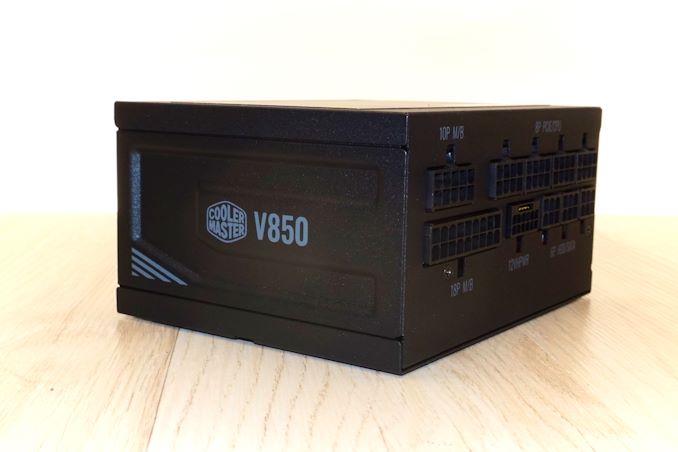
In response to the increasing popularity of compact and portable gaming PCs in the past couple of years, we've seen several PC peripheral manufacturers release larger collections of SFX form factor cases and power supplies. Chief among these has been Cooler Master, where the prolific PC part vendor recently expanded their SFX series to include ATX 3.0-compliant PSUs. This has finally given the company a modern, miniature platform that can drive the latest NVIDIA video cards.
Today we're looking at Cooler Master's V850 SFX Gold, which represents a more budget-friendly option in the SFX power supply market compared to their previously reviewed V1100 SFX Platinum. The SFX Gold series includes four models, ranging from 550W to 850W, with the 850W unit that we are reviewing today being the most potent. This 850-Watt power supply carries an 80 Plus Gold certification and is designed for high-performance gaming and workstation builds. As the top-tier model in the SFX Gold series, it offers substantial power output for an SFX unit and maintains ATX 3.0 compliance, including a 12VHPWR connector in a compact SFX format.
| Cooler Master V850 SFX Gold Power specifications ( Rated @ 50 °C ) |
|||||
| RAIL | +3.3V | +5V | +12V | +5Vsb | -12V |
| MAX OUTPUT | 20A | 20A | 70.8A | 3A | 0.3A |
| 120W | 849.6W | 15W | 3.6W | ||
| TOTAL | 850W | ||||
| 80PLUS RATING | Gold | ||||
| AC INPUT | 100 - 240 VAC, 50 - 60 Hz | ||||
| MSRP | $100 | ||||
Packaging and Bundle
Cooler Master packages the V850 SFX Gold in a robust and attractively designed cardboard box. The box's striking color scheme ensures it catches the eye on store shelves, while comprehensive details about the PSU and its features are provided on the sides and back of the box. Inside, the power supply is secured with substantial foam packaging, which is tailored to safeguard the unit during shipping.
Unlike what was the case with the Platinum series models, the bundle of the V850 SFX Gold is extremely frugal and limited to the necessary AC power cable and a basic leaflet. Strangely, the company advertises that the unit comes with an SFX-to-ATX adapter, but we found no such adapter included with the sample we received.
The Cooler Master V850 SFX Gold is a fully modular PSU, allowing for the detachment of every cable, including the 24-pin ATX cable. The connectors and wires are uniformly black, featuring ribbon-like "flat" wires, except for the 12VHPWR cable, which is sleeved. The cables are shorter than those typically found in ATX PSUs, which is advantageous for smaller cases and compact system builds where space is at a premium. The total number of connectors is somewhat limited given the power output of this model, but the true limitation here is found after taking a closer look at the 12VHPWR connector, which reveals that this cable limits the maximum power draw to 450 Watts. This would be perfectly acceptable for the less powerful units of the series but definitely not ideal on a product capable of outputting at least 850 Watts – unless it could not handle the power excursion requirements. Nonetheless, this connector can limit compatibility and overclocking with powerful graphics cards.
| Cooler Master V850 SFX Gold | ||
| Connector type | Hardwired | Modular |
| ATX 24 Pin | - | 1 |
| EPS 4+4 Pin | - | 1 |
| EPS 8 Pin | - | 1 |
| PCI-E 5.0 (450W) | - | 1 |
| PCI-E 8 Pin | - | 4 |
| SATA | - | 8 |
| Molex | - | 4 |
| Floppy | - | - |
The Cooler Master V850 SFX Gold PSU
External Appearance
A quick look at the Cooler Master V850 SFX Gold highlights its most basic achievement, with the company’s engineers having successfully created a platform capable of delivering 850 Watts of continuous power within the compact dimensions of a standard SFX form factor chassis, measuring 125 × 63.5 × 100 mm / 4.92 × 2.5 × 3.94 in (W×H×D). While the power-to-mass ratio of the V850 is commendable, it does not surpass the highest ratios we have observed in previous reviews. It would be very difficult to increase power density further without substantially increasing efficiency, otherwise thermal performance would become a major concern.
The chassis of the V850 SFX Gold maintains the standard SFX size and is finished in matte black paint. The left side of the unit features a distinctive geometric, C-like design, with the company and series logos prominently displayed in the center. A large sticker on the top side of the chassis provides the unit's certifications and specifications.
The rear side of the Cooler Master V850 SFX Gold is relatively straightforward, featuring the necessary AC cable receptacle and a small on/off switch, which is a practical addition given the compact size of the unit. The front side of the unit is densely arranged with connectors for the modular cables. Although these connectors are not color-coded, a basic legend is printed directly on the chassis to help identify each connector's function. All connectors are keyed to ensure correct and secure connections.
Internal Design
The 92 mm fan cooling the Cooler Master V850 SFX Gold is produced by Hong Hua (HA9215VH12FD-F00), a well-known manufacturer of high-quality fans. This low-profile fan, only 15 mm thick, reaches a maximum speed of 3000 RPM, which is very high, reflecting the necessity to efficiently manage heat in such a power-dense unit. It utilizes a fluid-dynamic bearing that offers extended durability and operates a little more quietly compared to standard ball bearing fans.
The OEM behind the creation of the Cooler Master V850 SFX Gold is a company called Gospower, and this is the first time that we've encountered one of their platforms. Having been founded in 2006 in China, they are a relatively new OEM of power electronic products, with the company focusing mostly on solar power products.
The interior of the Cooler Master V850 SFX Gold is remarkably dense, illustrating a masterful design approach to component arrangement. The filtering stage begins immediately behind the AC receptacle and includes an impressive array of components given the limited space: four Y capacitors, two X capacitors, and two filtering inductors - a comprehensive setup for a compact design. The unit features a single bridge rectifier, mounted on its own heatsink. There is a single bridge rectifier mounted on its own heatsink, which, though simple, provides adequate surface area and openings to facilitate airflow.
The APFC circuit is textbook but the active components share the same heatsink as the primary side inversion circuitry. The passive components are a massive 420V/730μF from Nippon Chemi-Con and a coil that take about 15% of the unit’s space all by themselves. On the primary side of the transformer, we find two 65T130F inversion MOSFETs that form a typical half-bridge LLC converter topology.
The six secondary side power transistors are found at the bottom side of the PCB, with a thermally conductive pad connecting them to the chassis, making the chassis itself work as their heatsink. They are six Infineon 12N04LM6 MOSFETs, of excellent quality. A vertical PCB on the secondary side of the transformer, across the edge of the PCB, holds the DC-to-DC circuits that generate the 3.3V and 5V lines. The secondary side capacitors are supplied by Nichicon (solid-state) and Lelon (electrolytic). Lelon is a Taiwanese manufacturer, and a good one, but their origin is especially notable here because Cooler Master's published specifications claim that the V850 is built with “Japanese capacitors”. Technically, this is correct – the specs don't say “100% Japanese capacitors” – so while the company is legally covered, Cooler Master's advertising of the PSU is deceptive in its omission.


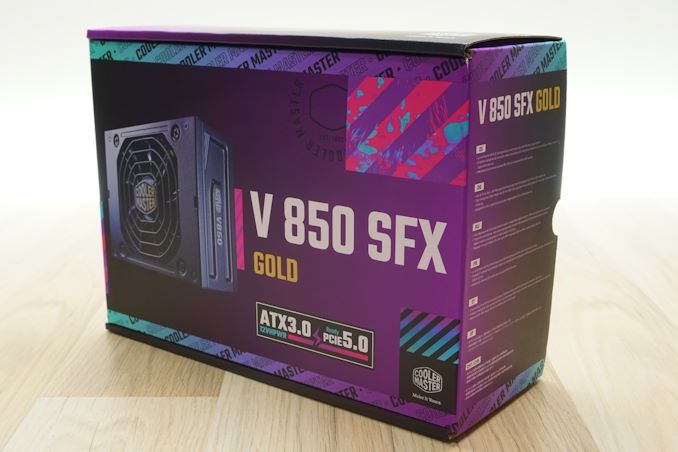
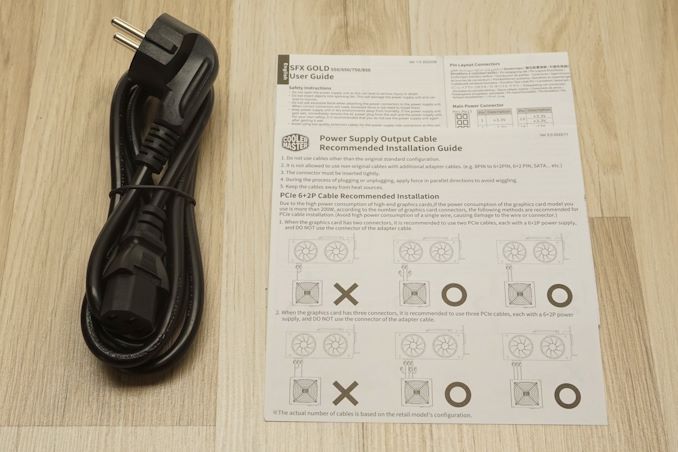
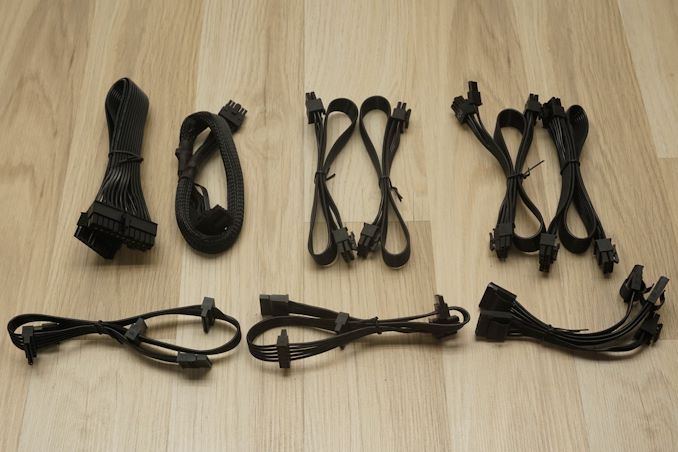
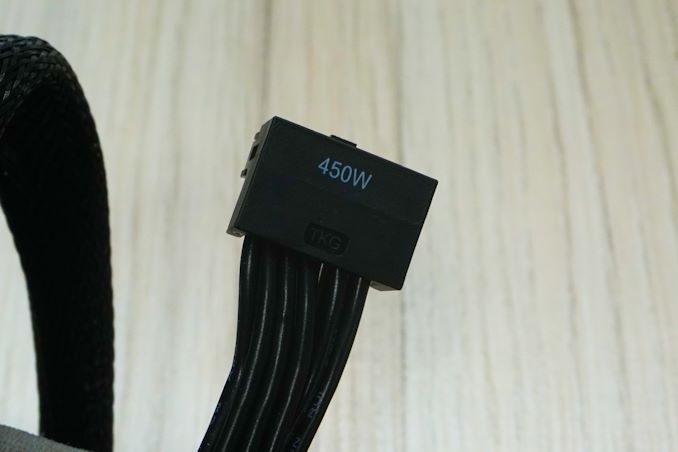
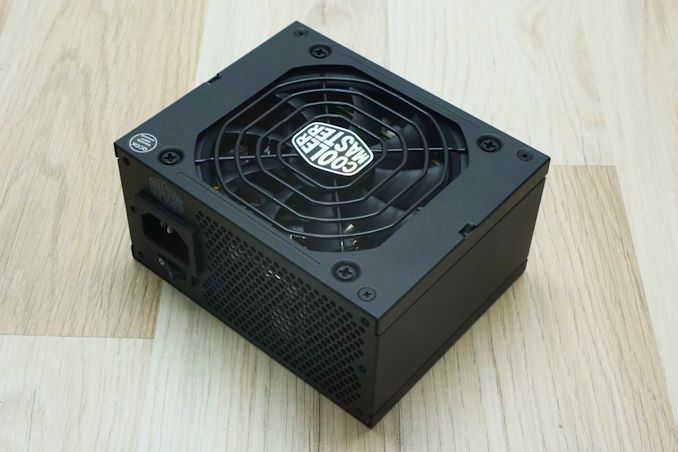
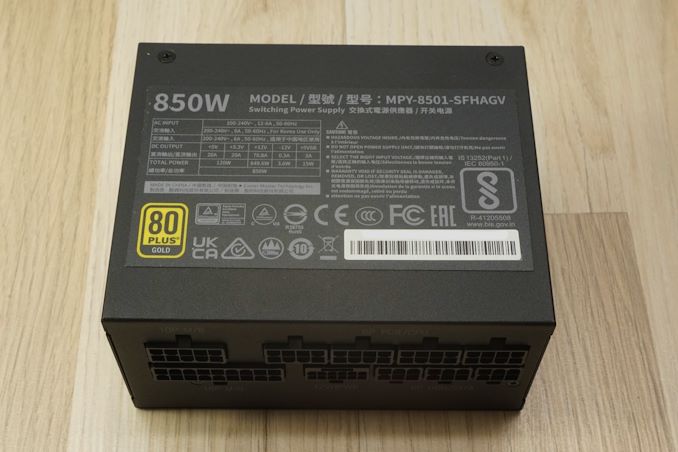
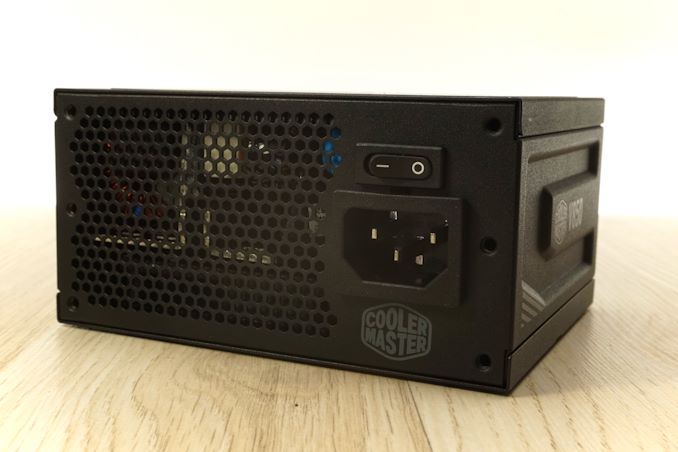
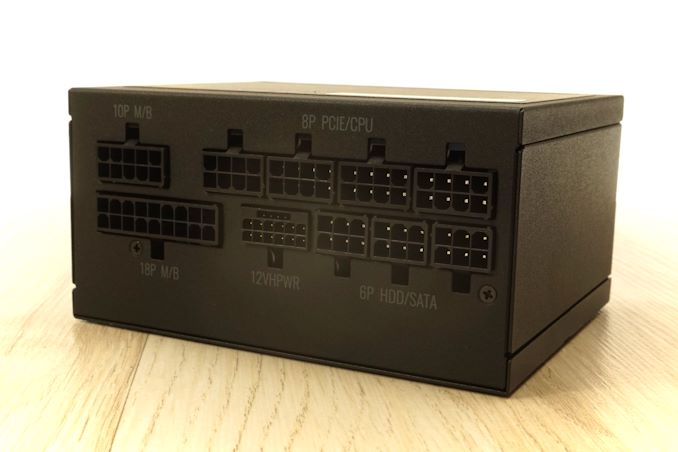


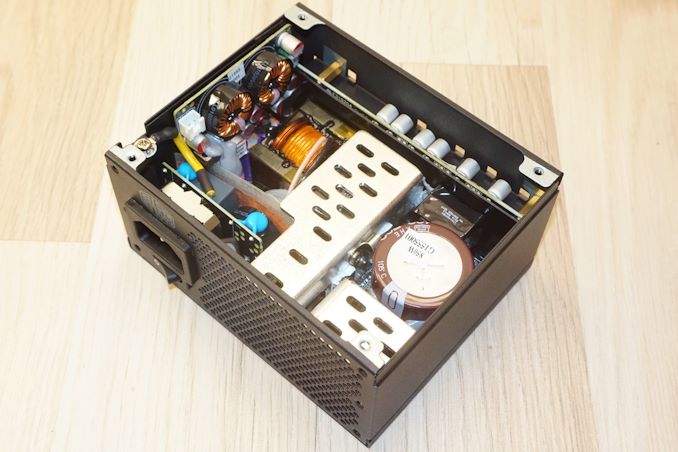
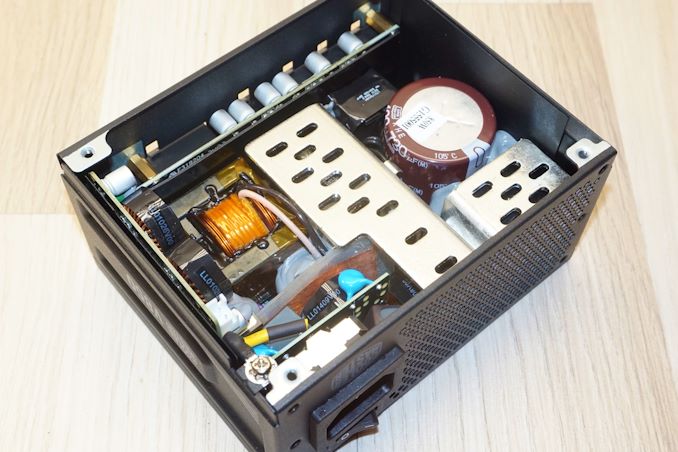

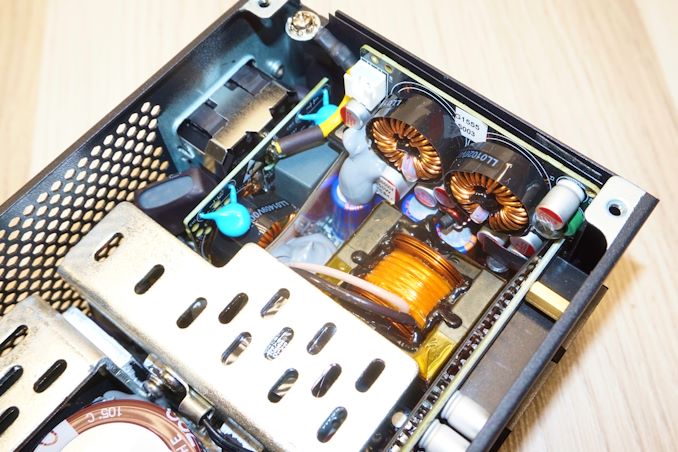
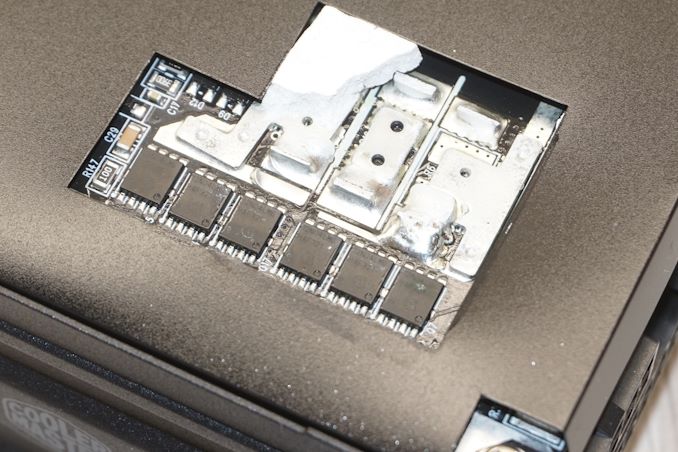








3 Comments
View All Comments
ballsystemlord - Thursday, June 20, 2024 - link
Those figures for hot box testing are some of the worst I've ever seen since I started reading AT. That being said, the PSU really does hold up well considering the thermal stress it must be under.But those capacitors are not going to last, Japanese or otherwise, if subjected to elevated temperature environment (e.g. many of glass paneled cases).
DanNeely - Wednesday, June 26, 2024 - link
Yeah. high wattage SFX isn't an easy target, but the last 2 reviews show much better can be done. Kinda curious if the problem is smaller heat sinks or worse air flow. Whatever it was if it couldn't be fixed, Corsair should've bit the bullet with a faster and louder fan to keep thermals under control.meacupla - Sunday, June 23, 2024 - link
I have this, or one of its versions. It came with my pre-built gaming PC and it is very loud.The fan doesn't ramp down after the PSU warms up from a 400~500W load from gaming. IDK if my version is an older one (because I don't have the box), but I need to power cycle to get the fan noise to reset.
I don't want to throw money at it to replace it. In the end, it's a gaming PC so I can live it being loud while gaming, but I would use a Corsair or Silverstone, given the choice.